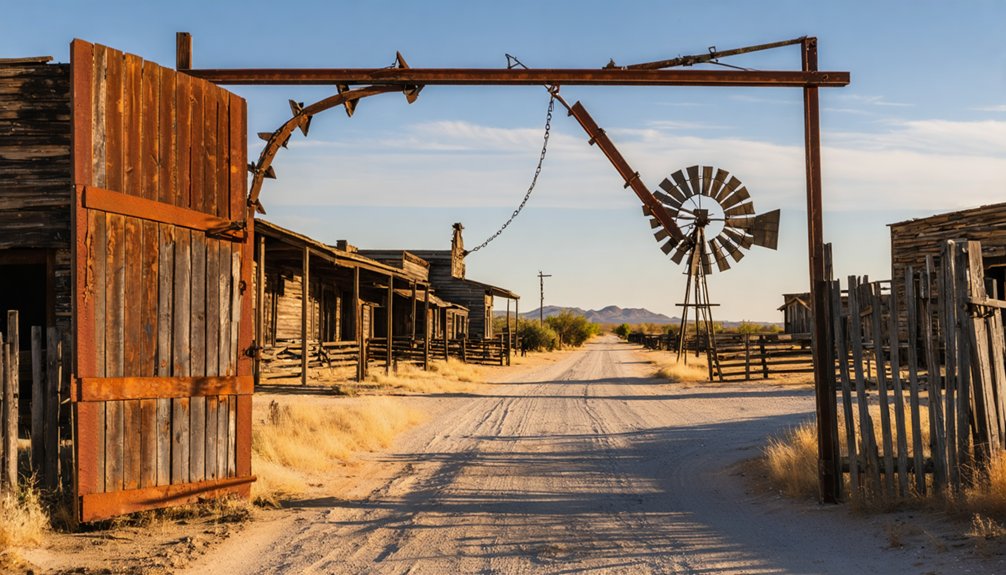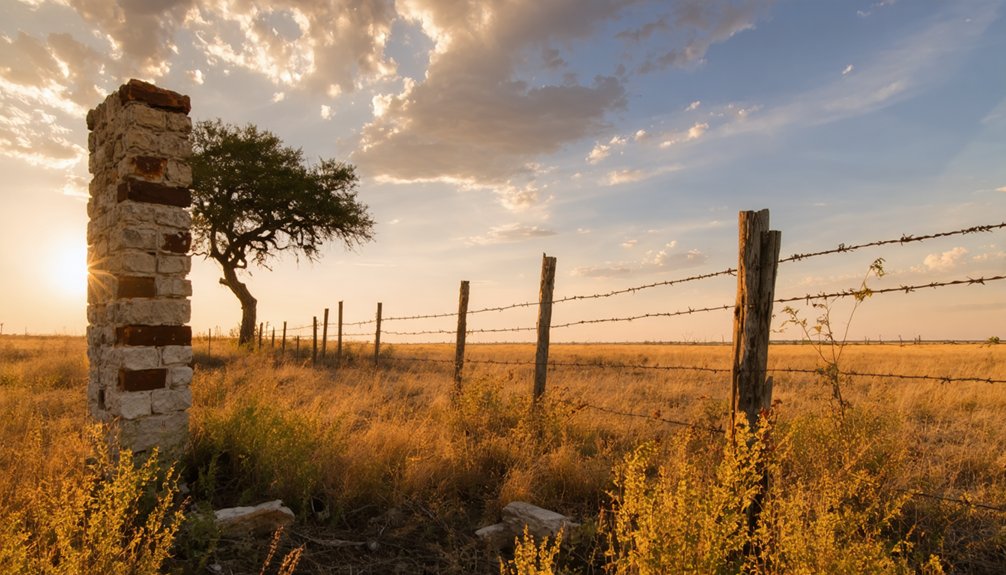You’ll find Doole, Texas – a ghost town 28 miles northwest of Brady – where a once-thriving ranching community flourished in the early 1900s. The town grew from 25 residents in 1914 to 250 by the 1940s, with ten businesses serving local needs. Post-WWII rural migration and agricultural changes led to its decline. Today, you can explore the ruins of the church, blacksmith shop, and other structures that tell Doole’s fascinating story.
Key Takeaways
- Doole is a ghost town located 28 miles northwest of Brady, Texas, that once had 250 residents during its 1940s peak.
- The town developed from a ranching community in the early 1900s, featuring essential services like schools, churches, and businesses.
- Economic decline began post-World War II due to rural migration, agricultural consolidation, and 1950s drought conditions.
- Historical structures still standing include ruins of a church, an intact blacksmith shop, and remnants of the old baseball field.
- Today, Doole maintains its ZIP code with few remaining residents while featuring a mix of inhabited and abandoned structures.
The Rise and Fall of a Ranching Community

While many small Texas towns emerged around railroads or oil fields, Doole’s story began with the Gansel family establishing a crossroads school in the early 1900s.
Originally named Gansel, the town adopted its current name in 1911 when postal authorities required a change, honoring Brady’s postmaster David Doole.
You’ll find Doole’s ranching heritage reflected in its rapid growth from 25 residents in 1914 to 250 by the 1940s.
The town’s community resilience showed through its development of crucial services – a school, church, diner, grocery store, and mechanic shop.
Located 28 miles northwest of Brady, it served as a crucial hub for surrounding ranch families.
Today, despite its ghost town status, Doole maintains its own zip code 76836.
Population has drastically declined since the peak years, dropping to 40 residents in the 1960s.
However, the devastating 1950s drought struck hard at Doole’s agricultural foundation, triggering an exodus that would transform this once-thriving ranching center into a ghost town.
Life in Early Doole: 1908-1940s
Though Doole began modestly with just 25 residents in 1914, this unincorporated Texas town grew into a vibrant community of 250 people by the 1940s.
You’d have found ten bustling businesses, including a diner, grocery store, and mechanic’s shop, serving the daily needs of locals. The Crossroads School, relocated from Fort Concho in 1908, and the local church became centers for community gatherings, while the school’s baseball field provided recreation for residents. Like the early settlements of their time, many families faced harsh conditions as women endured hard lives while helping establish the community.
Life revolved around educational institutions, religious activities, and local commerce. Despite the challenges of rural isolation – being 28 miles northwest of Brady – Doole’s residents maintained a self-sufficient lifestyle through ranching, farming, and various trades like blacksmithing. In August, the community would gather for their annual school reunion, a tradition that continues at the community center even today.
Despite its remote location, Doole thrived through local self-sufficiency, with residents uniting around schools, churches, and homegrown commerce.
The town’s spirit endured through its locally-owned businesses and tight-knit social bonds.
Economic Transformation and Population Decline
Despite Doole’s steady growth through the 1940s, the post-World War II era brought dramatic changes that would transform this once-thriving ranching community.
You’d have witnessed dramatic shifts in rural migration as economic sustainability became increasingly difficult for local families.
The transformation manifested in three critical ways:
- Agricultural consolidation eliminated small family farms, reducing local job opportunities.
- A devastating drought in the 1950s forced many remaining farmers to abandon their operations.
- The lack of industry diversification left no alternative employment options.
Like the coal miners of Thurber who received their wages through a company store system, local workers struggled with limited economic freedom.
The town, which had reached its peak of 250 inhabitants during the 1930s and 40s, saw its population steadily decline.
Historical Landmarks and Lost Places
The physical remnants of Doole’s history tell a compelling story through its weathered structures and cultural landmarks.
You’ll find the ruins of an old church that once served as the spiritual heart of the community, while the intact blacksmith’s shop and connected home showcase the town’s architectural significance. A preserved 1950s puzzle inside the blacksmith’s shop offers glimpses into daily life, contributing to cultural preservation efforts. Like the nearby town of Santa Rita, Doole gradually faded into history as economic opportunities diminished.
The town’s landscape is dotted with mid-20th century houses featuring characteristic porch swings, alongside remnants of the old baseball field where community gatherings once thrived.
The telephone office ruins and various business structures stand as silent witnesses to Doole’s vibrant past, when nearly ten establishments served the local population during the 1940s.
Modern-Day Ghost Town Experience
Modern-day Doole presents a unique blend of inhabited spaces and abandoned structures, where a handful of families maintain residence among the weathered ruins of this Texas ghost town.
While exploring the remnants of this once-thriving community, you’ll encounter a town that retains its distinct identity through its ZIP code and occasional community events at the local community center.
For visitor safety and authentic exploration, you’ll want to:
- Navigate carefully around the partially collapsed stadium seating and unstable stone walls
- Watch for natural hazards like bee colonies and termite-damaged structures
- Respect the few occupied homes while exploring the abandoned buildings
The lack of vandalism and commercial tourism infrastructure guarantees you’ll experience an authentic piece of rural Texas history, though you’ll need to prepare for self-guided exploration.
Frequently Asked Questions
Are There Any Surviving Members of the Original Gansel Family Still Living?
You can’t confirm if any Gansel descendants still live today, as there’s no documented family history tracking them. You’d need to research genealogical records to locate surviving family members.
What Natural Disasters or Extreme Weather Events Has Doole Experienced?
You’ll find that Doole’s weathered severe flood events from tropical storms and hurricanes, endured devastating drought periods, faced tornado risks, and experienced extreme heat waves throughout central Texas’s tumultuous climate history.
Were There Any Notable Crimes or Lawlessness During Doole’s Peak Years?
You’d be surprised, but there’s no evidence of significant crime incidents or law enforcement challenges during Doole’s peak years. Historical records show a peaceful ranching community without documented lawlessness.
Did Doole Have Its Own Cemetery, and Where Were Residents Buried?
You won’t find a dedicated Doole cemetery in historical records. Residents were likely buried in nearby Brady’s established grounds or in family plots throughout McCulloch County’s ranching communities.
What Native American Tribes Originally Inhabited the Area Before Doole’s Settlement?
Where cattle now graze, you’ll find the ancestral lands of Lipan Apache and Tonkawa Native tribes, who roamed these hunting grounds before being displaced by European settlers’ historical impact on Texas.
References
- https://www.ghosttowns.com/states/tx/doole.html
- https://www.desertedtexas.org/2015/07/doole-texas-76836/
- https://www.youtube.com/watch?v=i0N-REeLprk
- https://www.youtube.com/watch?v=BilAMjeQIn8
- https://www.tshaonline.org/handbook/entries/doole-tx
- https://en.wikipedia.org/wiki/Doole
- https://www.texasescapes.com/TOWNS/Doole/Doole.htm
- https://www.desertedtexas.org/blog/
- https://texashighways.com/travel-news/four-texas-ghost-towns/
- https://theforgottensouth.com/cheapside-texas-ghost-town-history/



